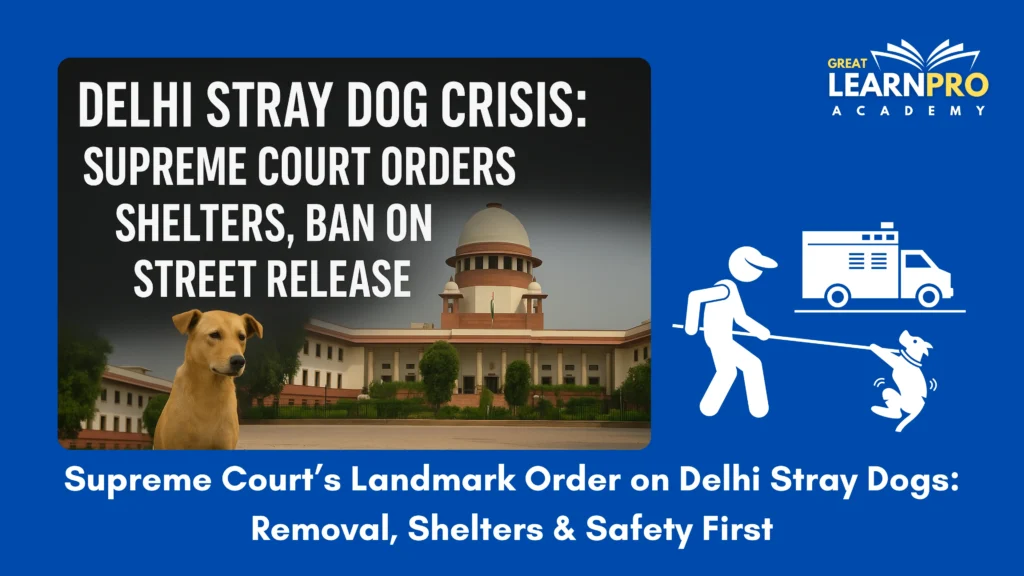
Delhi and its adjoining regions have long grappled with the menace of stray dogs. But the situation escalated dramatically, prompting the Indian Supreme Court to act via a suo motu case. Below is a comprehensive breakdown of how the issue unfolded and what the Court decreed.
1. How It All Began: Rising Menace Sparks Judicial Intervention
The judicial process began after a distressing media exposé titled “City hounded by strays, kids pay the price” highlighted the alarming number of dog bite incidents across Delhi, particularly affecting children. Motivated by these reports, the Supreme Court took up the matter on its own, treating it as a matter of public interest and safety.
Notably, hospital records revealed a staggering number of incidents—Delhi alone witnessed approximately 2,000 dog bite cases per day, while national data showed 430,000 cases in January 2025 alone, compared to 3.7 million during 2024.
2. Court’s Stern Diagnosis: “Extremely Grim Situation”
The bench, consisting of Justices JB Pardiwala and R Mahadevan, described the situation as “extremely grim,” especially for vulnerable groups like infants, the elderly, and the visually impaired. One of their pointed remarks questioned the logic behind the existing “capture-neuter-release” method, calling it absurd to return sterilized dogs to their original localities, where they continue to pose a threat.
3. Issuing the Directive: Removal, Relocation, and Penalties
On August 11, 2025, the Court issued a landmark directive comprising several mandatory steps:
- Removal and Rehabilitation: Authorities across Delhi-NCR including Delhi, Noida, Gurugram, and Ghaziabad were ordered to remove all stray dogs from streets, especially in high-risk and peripheral areas, and keep them in purpose-built shelters. Sterilized or not, dogs were not to be released back.
- Timeline and Capacity: For immediate impact, shelters capable of housing approximately 5,000 stray dogs were to be established within six to eight weeks. Capacity expansions were mandated over time.
- Infrastructure and Care: These shelters must include facilities for sterilization, immunization, and CCTV monitoring, to prevent escapes and ensure humane treatment. The Court specifically stressed that dogs must not suffer cruelty or neglect and there must be no overcrowding.
- Helpline and Monitoring: Authorities were required to establish a helpline within one week for reporting dog bites, with a mandate to respond within four hours. Daily records of captured dogs and vaccine availability needed to be logged and reported.
- Enforcement and Penalties: The Court issued a strict warning that any individual or organization obstructing the process would face legal or contempt action. Even the use of force was sanctioned if necessary to pick up stray dogs.
- No Adoption Back to Streets: Although adoption schemes were permitted, the Court clarified that no dog should be released back onto the streets, even after adoption consideration.
- Public Safety Priority: The ruling indicated that emotional attachments must not delay action, underscoring the overriding priority of public safety over sentimentality.
4. Aftermath and Legal Developments
The order drew strong resistance from animal welfare advocates, critics, and public figures. Many called the directive “unscientific,” “inhumane,” or “impractical,” pointing to the absence of adequate shelter infrastructure and alleging that it violated the Animal Birth Control (ABC) Rules, 2023. Responding to broader legal and ethical questions, the Supreme Court escalated the case from a two-judge bench to a three-judge bench, led by CJI BR Gavai, to revisit the directive amidst mounting controversy. Simultaneously, the Court reserved its stance on a plea seeking a stay on the order, expressing disappointment at the “inaction of local authorities” that had led to the crisis.
Summary of Key Facts
- Origin: Suo motu case based on media report detailing rampant dog bites, especially affecting children.
- Finding: The situation was severe and required urgent redress.
- Judgment (Aug 11, 2025): Mandated removal of stray dogs from Delhi-NCR, creation of shelters (5,000-dog capacity in 6–8 weeks), no release back, helpline with rapid response, and strong legal consequences for obstruction.
- Reception: Strong backlash regarding legality, ethics, feasibility, and conflict with existing ABC laws.
- Legal Developments: Case now under three-judge bench; courts highlighted administrative negligence as root issue, delaying further decisions.
The Supreme Court’s ruling marks a critical juncture in the balance between public safety and animal welfare. While the decision seeks to address the immediate health risks posed by uncontrolled stray dog populations, its success will depend on whether civic authorities can implement humane, large-scale shelter solutions in a short time. The debate now extends beyond the streets of Delhi, raising questions about urban animal management policies across India.
Sources:
- https://www.reuters.com/world/india/indias-top-court-orders-delhi-authorities-move-stray-dogs-shelters-2025-08-11/?utm_
- https://timesofindia.indiatimes.com/city/delhi/will-animal-rights-activists-bring-back-rabies-victims-supreme-courts-big-decision-on-delhi-dog-menace-city-recorded-2000-bites-daily/articleshow/123231421.cms?utm_s
- https://www.indiatimes.com/trending/delhi-stray-dog-case-moved-to-larger-supreme-court-bench-maneka-gandhi-calls-earlier-order-unworkable-rubbish-666704.html?utm_
More Current Affairs: https://learnproacademy.in/updates/
